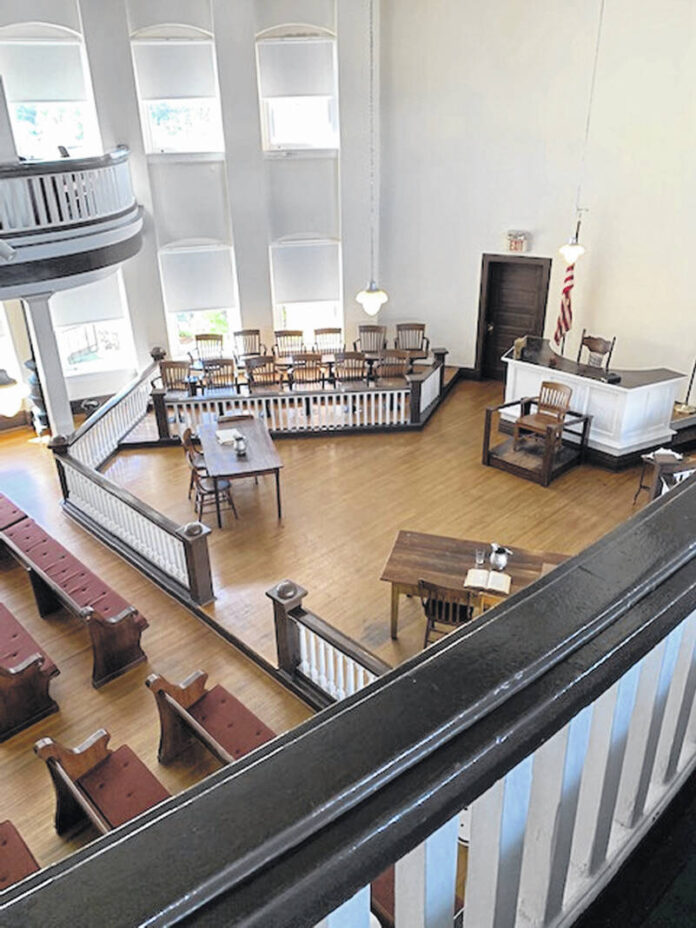
View from inside the original Monroeville County Courthouse’s courtroom in “To Kill a Mockingbird” author Nelle Harper Lee’s Alabama hometown of Monroeville. The courthouse was used until 1963 when a new courthouse was completed and is now a museum for the author, Lee, and her childhood friend, Truman Capote, and her book and movie version. The courtroom seen in the 1963 movie is an exact replica of this one.
Photo courtesy of John Grindrod
With the temperatures dropping along with fall’s curtain in just 48 hours, it’s time to put a wrap on my autumnal travel log. This week I’ll give you a few Alabaman snapshots.
In Birmingham, we stayed at another Drury Inn and Suites, a favorite chain of mine now for years, on the outskirts of the city of over 200,000. I purposely selected the hotel due to its proximity to Red Mountain Park.
At 1,500 acres, the park is one of the nation’s largest urban parks, actually larger than New York City’s Central Park. The park is, as the name suggests, located along a section of Red Mountain, land owned at one time by US Steel and mined for iron ore. We both took note of the decidedly orange color of the ground just off the wide soft turf of the main trail during our hike.
Along the path, signage provided details on what once was a thriving ore-mining industry and the people that worked the mines and extracted the city’s most valuable resource. For years a miner-dominated community thrived. At one time the area was indeed a boomtown in the early 20th century, and there were mining operations from the early 1900s through both World Wars and on into the 1950s. The last mine closed in 1962.
Following a brisk 90-minute hike, we were off to Selma. However, we vowed to keep our eyes sharp as we looked for a nice place to enjoy a picnic lunch. We found just such a place after we saw the sign for Natural Bridge Park.
We found a nice picnic table overlooking a dried-up creek bed under some tall pines and then went into a gift shop at the entry to the park. It was just $3.50 a piece to take the two-mile trail. We noted a lot of hemlocks and a wide variety of ferns as we made our way to a large cavern. Sixty feet above us was the natural bridge, 148-foot sandstone-and-iron ore arch.
The sign at the front of the park’s entry boasted it was the longest natural bridge east of the Rockies, one millions of years in the making. Some low-lying fog shrouded the cavern as we look up at the marvel, giving it a rather spooky effect, appropriate with Halloween just around the corner. Due to insurance concerns, no visitors are allowed to walk over the bridge. Actually Jane and I wouldn’t need to have been told that, since we do have a pretty healthy reserve of common sense.
Following our time in the park, we were back on the road to Selma. When we arrived, we easily found the famous, or should I say infamous, Edmund Pettus Bridge, one named for a brigadier general in the Confederate Army who also happened to be a state-ranking official in the Ku Klux Klan. The bridge was declared a National Historic Landmark in 2013, to acknowledge two famous Civil Rights marches that took place on the bridge in March of 1965, the second of which 48 hours after the first was led by Martin Luther King. We made the walk across the bridge, snapped a few photos and looked down on the Alabama River coursing far below before heading back to the car to continue on to our last stopover — Monroeville, a must for a couple of former English teachers like Jane and me, since Monroeville was where author Harper Lee was raised and lived her entire life.
The To Kill a Mockingbird author in this small town of just 6,000 people also had a childhood friend who would grow up to achieve great literary success as well. Truman Capote summered in the town with his aunts and cousins in the house right next to the Lees, and Lee and Capote became fast friends, a friendship that lasted all the way through to Capote’s death in 1984, 32 years before Lee’s passing.
Following our checking in at the appropriately named Mockingbird Inn on South Alabama Avenue, the same street where Lee and Capote lived, it was off to the downtown area to begin reading everything we could about Monroeville and about Lee and Capote. On our second day, we toured the old Monroe County Courthouse, now a museum that tells the stories of both authors’ time in Monroeville and their eventual literary successes.
The courtroom was a major attraction in the museum. It not only was the place where Lee’s father, a trial lawyer and the real-life model for Atticus Finch, tried many cases but also the model for the courtroom seen in the 1962 blockbuster movie based on the book. The movie starred Gregory Peck as Finch. Actually, Lee used her whole town as a model for the fictional town of Maycomb in the book.
Our two days were filled by taking several walks around this pretty little town, sampling some good Southern cuisine, namely cheesy grits and fried catfish at Hunters Run Bar and Grill, and admiring the magnolia trees that lined so many of the sidewalks.
Then, somewhat sadly, it was time to head north and get back to what needed doing. It was a trip both memorable and unique, so very different than the fall trips we’ve always taken in the New England and Mid-Atlantic states and one I recommend to all that want to view fall through a different lens.
John Grindrod is a regular columnist for The Lima News, a freelance writer and editor and the author of two books. Reach him at [email protected].






